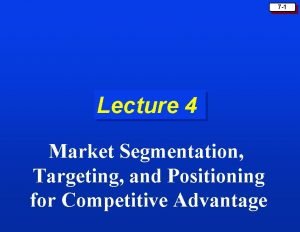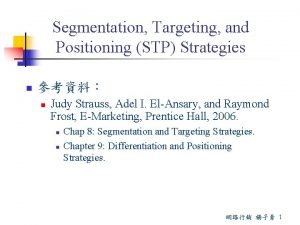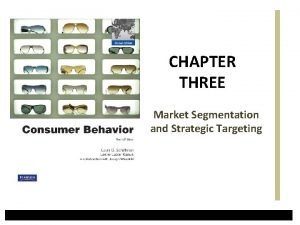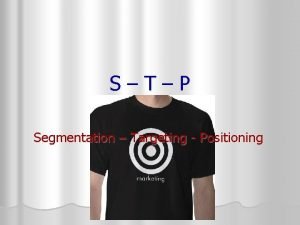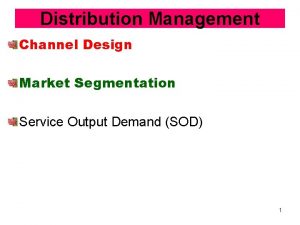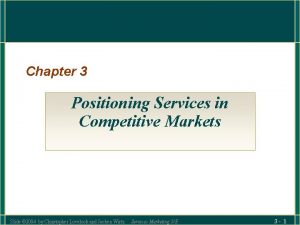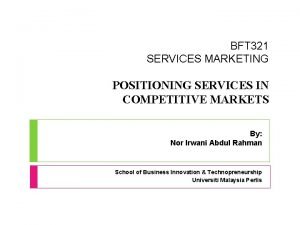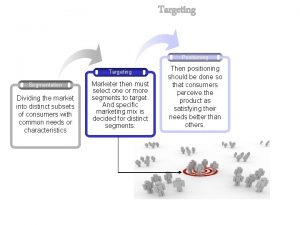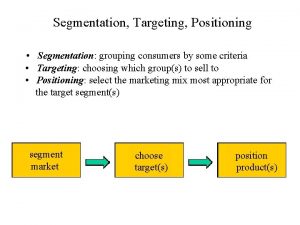CHAPTER 4 Market Segmentation Targeting and Positioning for

































- Slides: 33

CHAPTER 4 Market Segmentation, Targeting, and Positioning for Competitive Advantage Objective: explaining how companies segment, target and position for maximum competitive advantage

Markets n n n Originally, a market is a physical place where buyers and sellers gather to exchange goods and services. In marketing, a market is the set of all actual and potential buyers of a product or service. As marketing evolves in time, companies used different philosophies in their approaches to a market. Their thinking about serving a market passed through three stages;

n n n Mass marketing: here, the seller mass produces, mass distributes, and mass promotes one product to all buyers. In the very beginning, Mc. Donald’s offered just one type of hamburger to everyone. Mass marketing leads to lowest costs and prices and create the largest potential market. Product-variety marketing: here, the seller produces two or more products that have different features, styles, qualities, sizes… Later, Mc. Donald’s produced Big Mac to offer variety to buyers rather than appealing to different market segments. Product-variety marketing supports that consumers seek variety and change over time. Target marketing: here, the seller identifies market segments, selects one or more of them, and develops products and marketing mixes for each. Today, Mc. Donald’s offers different menus for different markets.

Micromarketing n n Today companies are using target marketing instead of mass marketing and product-variety marketing. Even, today, target marketing is taking the form of micromarketing - designing the companies marketing programs to the needs and wants of narrowly defined segments, often called niche marketing. “There will be no market for products that everybody likes a little, only for products that somebody likes a lot”.

Steps in Target Marketing 1. Market segmentation; dividing a market into distinct groups of buyers with different needs, characteristics or behaviors who might require separate products or marketing mixes. 2. Market targeting; evaluating each market segment’s attractiveness and selecting one or more of the market segments to enter. 3. Market positioning; setting the competitive positioning (difference) for the product and creating a detailed marketing mix.

Bases for Segmenting Consumer Markets n There are various ways to segment a market. A marketer has to try different segmentation variables, alone and in combination to understand the structure of the market in the best way. The major variables are; geographic segmentation n demographic segmentation n psychographic segmentation n behavioral segmentation n

Geographic Segmentation Companies may divide the market into different geographic units such as nations, countries, regions, cities… n A company may decide to operate in one or more geographic locations but it must pay attention to the geographical differences in needs and wants. n E. g. Mc. Donald’s serve corn soup in Japan, pasta salads in Rome, wine in Paris. . . n

Demographic Segmentation n Companies divide the market into groups based on; n age and life-cycle: needs and wants change with age, that is why, a company may use different marketing approaches for different age and lifecycle groups. Lewi’s 501 and Pepsi “generation next” are mainly targeted to the young people.

gender: is mainly used in clothing, cosmetics, and magazines. Coca Cola Light is targeted to women, whereas Pepsi Max is to men. n income: is mainly used for automobiles, boats, clothing, cosmetics, financial services, and travel. Credit cards are offered as ordinary, gold, platinum cards for different income groups; Holiday Inn offers upscale properties “Crowne Plaza”, economy properties “Hampton Inn”, luxury “Embassy Suites”; Vakko and Beymen target the high income group whereas Tiffany & Tomato to low income. n

Psychographic Segmentation n Companies may divide the market into different groups based on; n n n social class: has a strong effect on preferences in cars, clothes, home furnishings, leisure activities… Sports International, Bilkent and Or-an are targeted to people at higher social class. lifestyle: Mezzaluna targets to a business lifestyle, whereas the rest of the restaurants in Ankuva to a student lifestyle. personality: mainly used for cosmetics, cigarettes, and liquor. Marlboro is targeted to the macho man with its macho Cowboy image.

Behavioral Segmentation n Companies may divide buyers into groups based on their knowledge, attitudes, uses or responses to a product. n n occasions: buyers can be grouped according to occasions when they buy or use an item. Coca Cola is for “Always” benefit sought: buyers can be grouped according to the benefits that they seek from the product. In the toothpaste market, benefit segments are - economic, medicinal, cosmetic, and taste; detergent market cleanliness, cost; sewing gum - healthy teeth, fresh breath…

n n n user status: markets can be segmented into groups of nonusers, ex-users, potential users, first-time users and regular users of a product. Potential users and regular users may require different kinds of marketing appeal from each other. usage rate: markets also can be segmented into light-, medium-, and heavy- user groups. Most beer companies target the heavy beer drinker. loyalty status: a market can also be segmented by consumer loyalty. Consumers can be loyal to brands (Alo), stores (Vakko), and companies (BMW) Consumer may be completely loyal (buy one brand all the time), somewhat loyal (favor one brand, sometimes buying others), no loyalty (each time they buy a different product)

Segmenting International Markets n n Large companies e. g. Coca Cola, Sony… sell products in many different countries which vary in their economic, cultural and political make up. That is why, international firms need to group their world markets into segments with distinct buying needs and behaviors. Several variables can be used to segment international markets; n geographic location; grouping countries by regions e. g. Europe, Middle East.

n n n economic factors; grouping by population income levels or by their overall level of economic development. A company’s economic structure shapes its population’s product and service needs, therefore, the marketing opportunities that it offers. political and legal factors; grouping by the type of stability of government, receptive to foreign firms, monetary regulations, and the amount of bureaucracy. Such factors can play a crucial role in a company’s choice of which countries to enter and how. cultural factors; grouping markets according to common languages, religions, values and attitudes, customs and behavioral patterns.

n Some companies do not prefer to segment the international markets on the basis of geographic, economic, political, cultural, and other factors. Instead they prefer to do intermarket segmentation in which companies form segments of consumers who have similar needs and buying behavior even though they are located in different countries. E. g. teenagers live surprisingly parallel lives all around the world e. g. drink Coke, eat Big Macs, surf on the Net, wear bluejeans. Recently Pepsi introduced its sugar-free Pepsi Max in 16 countries with a single ad for teenagers who like to be on the wild side.

Market Targeting Evaluating Market Segments n n After segmenting the whole market, the firm has to evaluate these segments and decide how many and which ones to target. The company should enter segments only where it can offer superior value and gain advantages over competitors. In evaluating different market segments, a firm must look at three factors: n segment size and growth; companies try to select the segment with “right size and growth” for themselves. Some companies prefer to target segments with large current sales, a high growth rate, and a high profit

n n margin. But smaller companies may find these large segments too competitive and may find themselves having lack of skills and resources, therefore, prefer to target smaller segments segment structural attractiveness; a segment may have the right size, but not offer attractive profits if (1) there are strong competitors; (2) actual or potential substitute products - may limit prices and profits; (3) buyers with power - buyers may have strong bargaining power relative to sellers so that they may force prices down, demand more quality, set competitors against another; (4) powerful suppliers - can control prices, reduce quality. company objectives and resources; a segment may have the right size with attractiveness but may not suit with the long-run objectives of the company.

Selecting Market Segments The company must decide which and how many segments to serve, in other words, the company must decide which market-coverage strategy to adopt. n There are three market-coverage strategies: n undifferentiated marketing n concentrated marketing n

Market-Coverage Strategies n Undifferentiated Company marketing mix Market marketing n Differentiated Co. marketing mix 1 Co. marketing mix 2 Co. marketing mix 3 Company marketing mix Segment 1 Segment 2 Segment 3 marketing n Concentrated marketing

Undifferentiated Marketing n n n A market-coverage strategy in which a firm decides to ignore market segment differences and go after the whole market with one offer. Here, the offer focus on what is common in the needs of consumers rather than on what is different. The company designs a product and a marketing program that appeal to largest

n n number of buyers. It relies on mass advertising and a superior image in people’s minds. E. g. Levis 501. Provides cost effectiveness because of its low production, inventory, transportation, advertising, marketing research costs. Have difficulties in (1) developing a product or brand that satisfies all consumers; (2) keeping a strong place in the market and making profit, when several firms follow this strategy heavy competition develops; (3) satisfying smaller segments.

Differentiated Marketing n n A coverage strategy in which a firm decides to target several market segments and designs separate offers for each. E. g. Nike offers athletic shoes for different sports such as running, aeobics, cycling, baseball, basketball, tennis… These companies hope for (1) higher sales; (2) a strong place within each market segment; (3) more loyal customers because the firm’s offerings match each segment’s desires better.

n n Creates better total sales, but increases the costs - developing separate marketing plans for the separate segments requires extra marketing research, sales analysis, promotional planning, channel management. Because of the high costs involved in this approach, the company must compare increased sales with increased costs when deciding to use differentiated marketing strategy.

Concentrated Marketing n n n A market-coverage strategy in which a firm goes after a large share of one or a few submarkets. Suitable for smaller companies to achieve a strong market place in the segments (or niches) that it serves because of its greater knowledge of the segment’s needs. Involves higher-than-normal risks because the target may not respond or larger competitors may decide to enter the same market but offers operating economies because of specialization in production, distribution, and promotion.

Choosing a Market-Coverage Strategy n Factors needed to be considered when choosing a market-coverage strategy are; n n company resources; when the firm’s resources are limited, concentrated marketing is the better. product variability; for uniform products e. g. grapefruit or steel, undifferentiated marketing is more suitable. But for products that vary in design e. g. cameras or automobiles, differentiated or concentrated is more suitable.

n n n product’s stage in the life cycle; when the product is new, it is better to produce only one version of the product - undifferentiated or concentrated marketing. For mature products, differentiated marketing makes more sense. market variability; when buyers have the same tastes and react the same way to marketing efforts, undifferentiated marketing is suitable. competitor’s marketing strategies; when competitors use segmentation, undifferentiated marketing can be suicidal. On the contrary, when competitors use undifferentiated marketing, a firm can gain an advantage by using differentiated or concentrated marketing.

Positioning for Competitive Advantage Once a company has decided which segments to enter, it must decide what “positions” it wants to occupy in those segments. n A product’s position is the place the product has in consumer’s minds relative to competing products. In other words, a product’s position is the set of perceptions, impressions, and feelings that consumers n

hold for the product compared with competing products. E. g. Toyota is positioned on economy, Mercedes and Cadillac on luxury and Porsche and BMW on performance, Volvo on safety. n Consumers simplify the buying process by categorizing products in their minds. Marketers do not leave their products’ positions to chance. They must plan positions that will give their products the greatest advantage in selected target markets.

Positioning Strategies n Marketers can position (differentiate) their products on; n product: a company can differentiate its physical product from the competitors e. g. product feature Volvo provides safety, Delta Airlines offers wider seating and free in-flight telephone use; product performance - Vestel Washing Machine offers express washing, Rinso offers better whiteness; style and design - Porsche offers unique look; atmosphere - Hard Rock Café is special with its

n n interior design, Ciragan Palace with its building; place - Swiss Hotel offers the best Bosphorus view. . . service: a product can be differentiated by its speedy, convenient or careful service delivery e. g. Akbank offers full banking services at home, Garanti offers service during the lunch time, Osmanli Bank offers branches in supermarkets, Migros offers home delivery, Mc. Donald’s offer training for its franchisees… personnel: a company can hire better people than competitors do e. g. Singapore Airlines is well known with its beautiful flight attendants, IBM’s people are professional, Mc. Donald’s people are polite…

n n image: a company may establish an image different from the competitors e. g. Motorola “quality”. Symbols, famous people and sponsorship can be used to create image. benefits: a product’s benefit can be differentiated e. g. Nazar chewing gum protects from the devil eyes, Orbit offers teeth protection, Colgate offers better taste. . . usage occasions: a product’s position can be positioned according to the time of using the product e. g. Hilton “when American business take the family along, American business stays at Hilton”. . . user category: a product can be positioned for some people e. g. Johnson&Johnson’s baby

n n n shampoo, Pepsi Max for adventurous men… against another product: this approach can be named as competitive advertising where the company positions itself directly against one competitor e. g. Avis “we try harder” against Hertz, Wendy’s “where is the beef? ” against Mc. Donald, Sabah against Milliyet; Burger King against Mc. Donald; Sheraton against Hilton… product class dissociation: a product may also be positioned away from all competitors e. g. Sprite has positioned itself against the “cola” products, Yapi Kredi claims to be giving the best services… price: a product can be differentiated by using its price. The product would be having the lowest price in the market e. g. Alo.

n After the company selects the right position for itself, it must communicate and deliver the chosen position with promotions.
 Segmentation targeting and positioning
Segmentation targeting and positioning Sony market segmentation, targeting and positioning
Sony market segmentation, targeting and positioning Chosen lesson 7 segment 1
Chosen lesson 7 segment 1 Case study segmentation targeting positioning
Case study segmentation targeting positioning Market segmentation, targeting and positioning
Market segmentation, targeting and positioning Benefits of market segmentation targeting and positioning
Benefits of market segmentation targeting and positioning Differentiated undifferentiated and concentrated marketing
Differentiated undifferentiated and concentrated marketing Global market segmentation
Global market segmentation Nivea segmentation
Nivea segmentation Segmentation targeting differentiation and positioning
Segmentation targeting differentiation and positioning For upscale american families volvo
For upscale american families volvo Segmentation targeting and positioning of nestle
Segmentation targeting and positioning of nestle Pepsodent target market
Pepsodent target market Segmentation
Segmentation Stp segmentation targeting positioning
Stp segmentation targeting positioning Global segmentation strategy
Global segmentation strategy Global segmentation targeting and positioning
Global segmentation targeting and positioning Segmentation vs targeting
Segmentation vs targeting 7 principles of marketing
7 principles of marketing Segmentation bases
Segmentation bases Customer segmentation & targeting
Customer segmentation & targeting Stp in rural marketing
Stp in rural marketing Marketing segmentation table
Marketing segmentation table Hcp segmentation
Hcp segmentation Strategie positioningu
Strategie positioningu Stp marketing
Stp marketing Resume jurnal
Resume jurnal Resume jurnal
Resume jurnal User status segmentation examples
User status segmentation examples Leader follower challenger nicher
Leader follower challenger nicher Family life cycle stages
Family life cycle stages Market segmentation and service output demand
Market segmentation and service output demand Positioning services in competitive markets
Positioning services in competitive markets Market orientation
Market orientation




